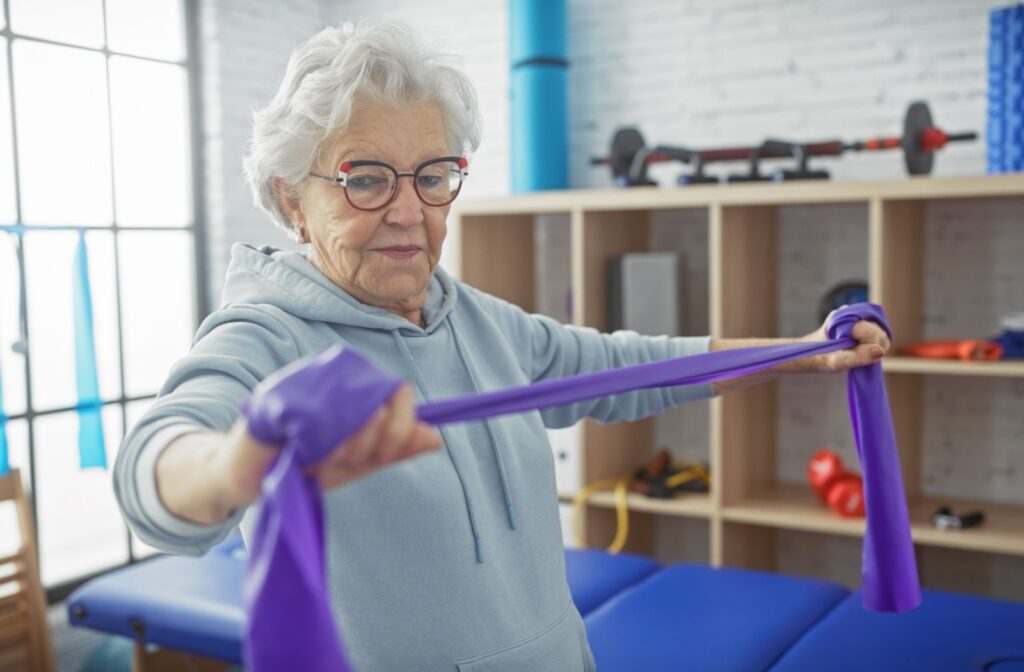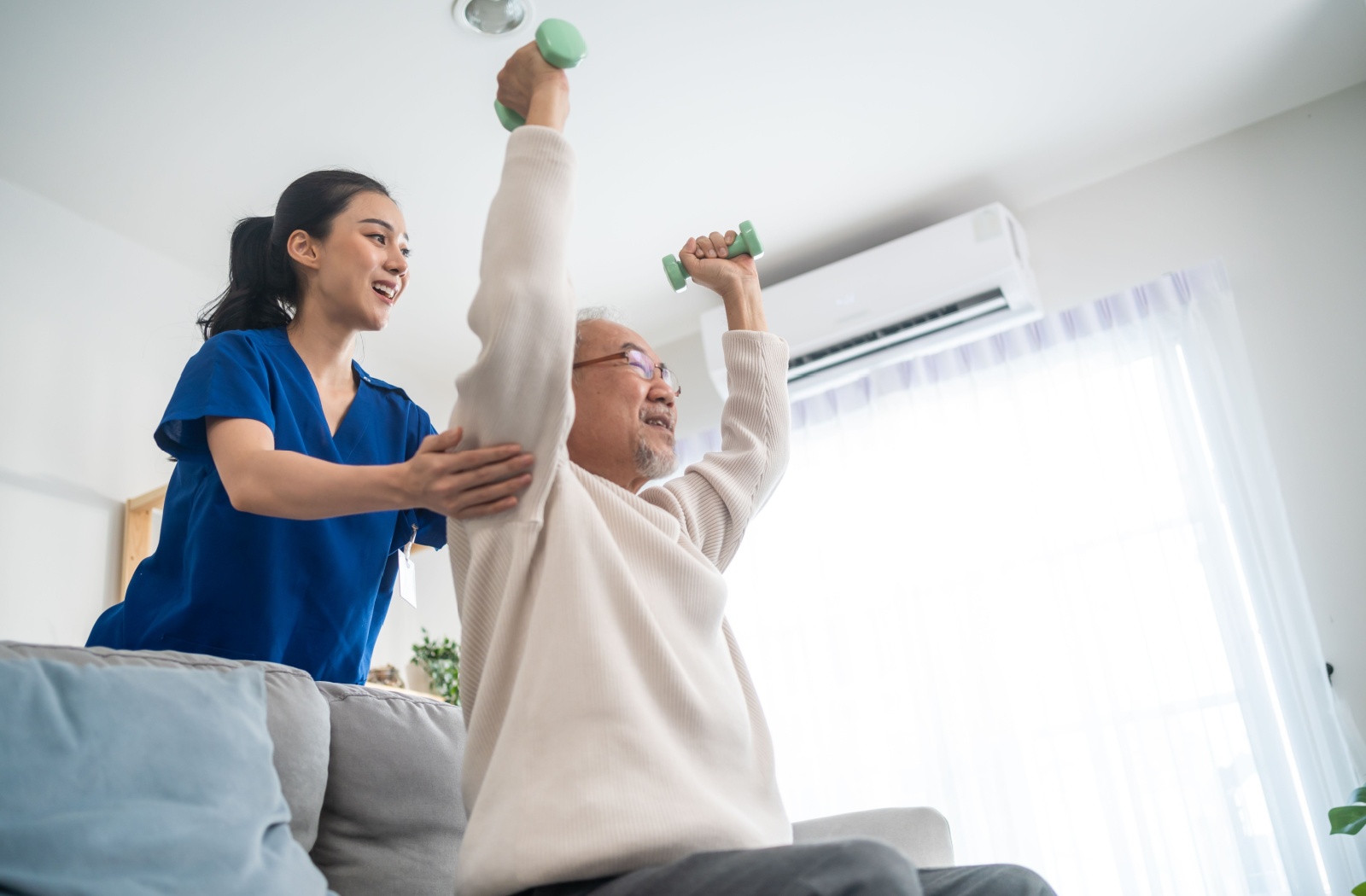Aging is a part of our journey through life. As we age, we strive to maintain our independence and live with dignity by caring for our physical, mental, and emotional health. But due to natural changes in our bodies and abilities, the risk of things like trips and falls can increase, leading to an increased risk of injury.
Occupational therapy can help you maintain your mobility and reduce the chances of accidents. Occupational therapy activities for the elderly include:
- Balance exercises
- Strength-building exercises
- Coordination exercises
What can make these activities so effective for you is that your occupational therapist or personal trainer can tailor each activity to nearly any skill and mobility level. Whether you’re already in great shape or need help getting there, activities and exercises can scale to where you’re at.
Another benefit of occupational therapy is its role in healing and recovery. For example, a tailored exercise plan can help you recover faster from a fall and help prevent future falls.
The Reality of Fall Risks for Seniors
Falls are the most common cause of injuries among seniors. Falls can result in fractures, head traumas, or even necessitate hospitalization. But the impact of falls extends beyond physical injuries and can cause emotional distress. Experiencing a fall can lead to a loss of self-confidence, resulting in anxiety and social isolation and diminishing your overall quality of life.
But why are seniors more susceptible to falls? A few reasons include:
- Changes in physical ability and mobility: Aging can lead to reduced muscle strength, stiff joints, and slower reflexes, making it challenging to regain balance.
- Health conditions: Chronic diseases such as arthritis, Parkinson’s, foot pain, and vision impairment often increase the risk of falls.
- Medication side effects: Some medications cause side effects such as dizziness or low blood pressure, which can increase the risk of falls.
- Environmental hazards: Everyday surroundings like loose carpets, cluttered walkways, or poorly lit stairs can pose risks for seniors.
Given these risks, it’s essential to prevent falls before they occur and impact your physical and emotional health.
The Role of Occupational Therapy in Senior Care
Occupational therapy provides a critical approach to well-being. It focuses on helping people perform the activities that matter most in their daily lives, tasks that bring joy and purpose, or help us get through the day.
Occupational therapy is critical for seniors attempting to perform daily activities safely. Its focus isn’t on physical ability alone. It’s on what’s meaningful and finding innovative, practical ways to make these tasks easier and safer for people of all ages and abilities.
Occupational therapists are trained to evaluate a person’s living space, abilities, and habits and recommend changes to reduce risks and increase safety. An occupational therapist might do the following in a typical visit:
- Identify possible fall risks in the home (e.g., tripping hazards or poor lighting)
- Suggest modifications with senior-friendly solutions like grab bars or non-slip flooring
- Propose activities to enhance mobility while remaining within their abilities
Occupational therapy empowers seniors to live confidently, making daily routines less intimidating.
Occupational Exercises & Activities for Seniors
Physical strength, balance, and coordination are essential in preventing falls. Occupational therapists create personalized exercise programs that seniors can seamlessly integrate into their daily routines.
Here are some examples of how occupational therapy might look in your life.
Balance Exercises
Balance is a critical component in fall prevention. You may perform activities like standing on one leg or walking heel-to-toe across the room. These can help improve stability over time, and your occupational therapist can tailor them to your ability level.

Strength Training
Strength training doesn’t mean you go to the gym and lift heavy weights. It’s as simple as exercises using light weights or resistance bands to build muscle and support proper posture and mobility. Your occupational therapist can show you the correct exercises to do after assessing where your strengths and weaknesses are.
Coordination Activities
Daily tasks like stepping over low objects can encourage proper foot placement and balance. Activities like chair yoga or tai chi can also help enhance your coordination. They will also improve strength, flexibility, and mobility in many cases—not to mention the relaxation benefits for your mental health.
Assistive Equipment for Seniors
Sometimes, devices that can maintain or enhance mobility can make a world of difference. Occupational therapists are proficient at pairing seniors with tools that provide the extra support they need. These can range from simple items to more complex installations:
- Button hook: This simple tool enables people to button shirts single-handedly.
- Raised toilet seats: These make sitting and standing easier and may include side rails or back supports.
- Grab bars and handrails: These permanent installations can be strategically placed in high-risk zones like bathrooms and staircases.
- Non-slip mats: These can be placed in bathtubs and showers to prevent slipping.
- Specialized cutlery: Utensils can have thick handles, be heavier than normal, have a useful bend, or come with a hand strap for secure holding, depending on a person’s needs.
Maintain Your Confidence in Senior Living
Preventing falls doesn’t mean upending your life. We can improve everyday living by making small, thoughtful adjustments and implementing personalized care plans. By preventing falls, we can reduce accidents and support a full, confident, and dignified life for older adults.If you’re contemplating occupational therapy for yourself or a loved one, look no further. Discover how All American Assisted Living at Raynham supports our residents on their unique healing journeys with skilled team members. Contact us today to learn more about our community.





